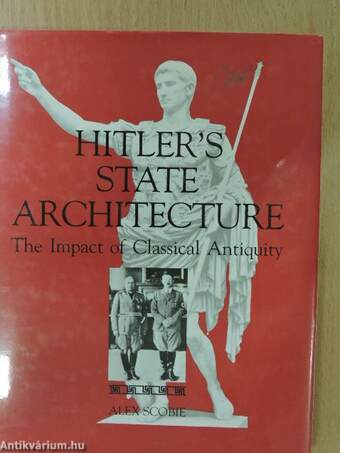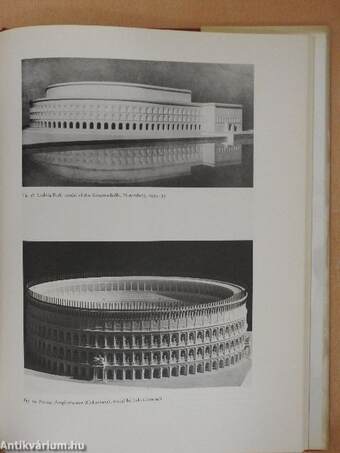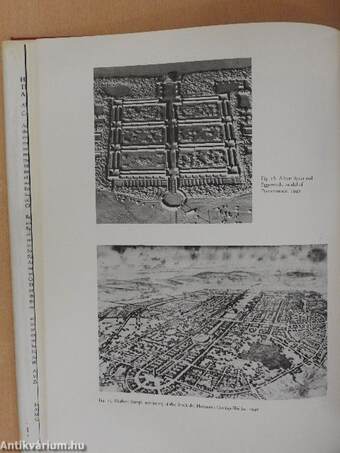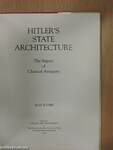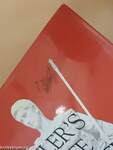1.113.949
kiadvánnyal nyújtjuk Magyarország legnagyobb antikvár könyv-kínálatát
Hitler's State Architecture
The Impact of Classical Antiquity
| Kiadó: | The Pennsylvania State University Press |
|---|---|
| Kiadás helye: | London |
| Kiadás éve: | |
| Kötés típusa: | Vászon |
| Oldalszám: | 152 oldal |
| Sorozatcím: | CAA Monograph Series |
| Kötetszám: | 45 |
| Nyelv: | Angol |
| Méret: | 29 cm x 22 cm |
| ISBN: | 0-271-00691-9 |
| Megjegyzés: | Fekete-fehér fotókkal illusztrálva. |
naponta értesítjük a beérkező friss
kiadványokról
naponta értesítjük a beérkező friss
kiadványokról
Előszó
TovábbFülszöveg
Hitler's State Architecture: The Impact of Classical Antiquity
Alex Scobie
CAA Monograph XLV
Adolf Hitler admired ancient Rome as the "crystallization point of a world empire," a capital with massive public monuments that reflected the supremacy of the State and the political might of the ancient world's "master-race." He also admired the way Mussolini turned the monuments of imperial Rome into validatory symbols of Fascism. Hitler planned a Reich that would be as durable as the Roman Empire. Its capital, Berlin, would surpass the architectural magnificence of ancient Rome before the advent of Christianity as its official religion.
This book examines Hitler's views on Roman imperialism, town planning, and architecture, and shows how Albert Speer, though a self-confessed student of "Doric" architecture, planned and sometimes built structures that were intended to rival such monuments as Nero's Golden House, Hadrian's Pantheon, and the Stadium of Heródes Atticus at Athens. Other... Tovább
Fülszöveg
Hitler's State Architecture: The Impact of Classical Antiquity
Alex Scobie
CAA Monograph XLV
Adolf Hitler admired ancient Rome as the "crystallization point of a world empire," a capital with massive public monuments that reflected the supremacy of the State and the political might of the ancient world's "master-race." He also admired the way Mussolini turned the monuments of imperial Rome into validatory symbols of Fascism. Hitler planned a Reich that would be as durable as the Roman Empire. Its capital, Berlin, would surpass the architectural magnificence of ancient Rome before the advent of Christianity as its official religion.
This book examines Hitler's views on Roman imperialism, town planning, and architecture, and shows how Albert Speer, though a self-confessed student of "Doric" architecture, planned and sometimes built structures that were intended to rival such monuments as Nero's Golden House, Hadrian's Pantheon, and the Stadium of Heródes Atticus at Athens. Other architects, such as Ludwig Ruff and Cäsar Pinnau, were to plan structures inspired by the Colosseum and the Baths of Caracalla. The ancient Roman obsession with order, discipline, and the domination of the environment is clearly reflected in the town plans and public buildings conceived by Hitler and his architects.
We see that "neoclassical" state architecture in Nazi Germany was intended to signify more than stability and the persistence of tradition. It was only one aspect of the Nazi attempt to re-create a "pagan" totalitarian state based on clearly defined forms of hierarchy that divided society into slaves and slave-owners, those with and those without human rights.
Alex Scobie is Reader in Classics at the Victoria University of Wellington, New Zealand. Vissza
Témakörök
- Idegennyelv > Idegennyelvű könyvek > Angol > Művészetek > Építészet
- Művészetek > Építészet > Korszakok, stílusok > XX. század > Egyéb
- Művészetek > Építészet > Kontinensek szerint > Európa > Német
- Művészetek > Építészet > Idegen nyelv > Angol
- Művészetek > Építészet > Várostervezés, városrendezés > Külföldi
- Művészetek > Építészet > Összefoglalók > Külföldi
- Művészetek > Építészet > Építészettörténet > Külföldi


